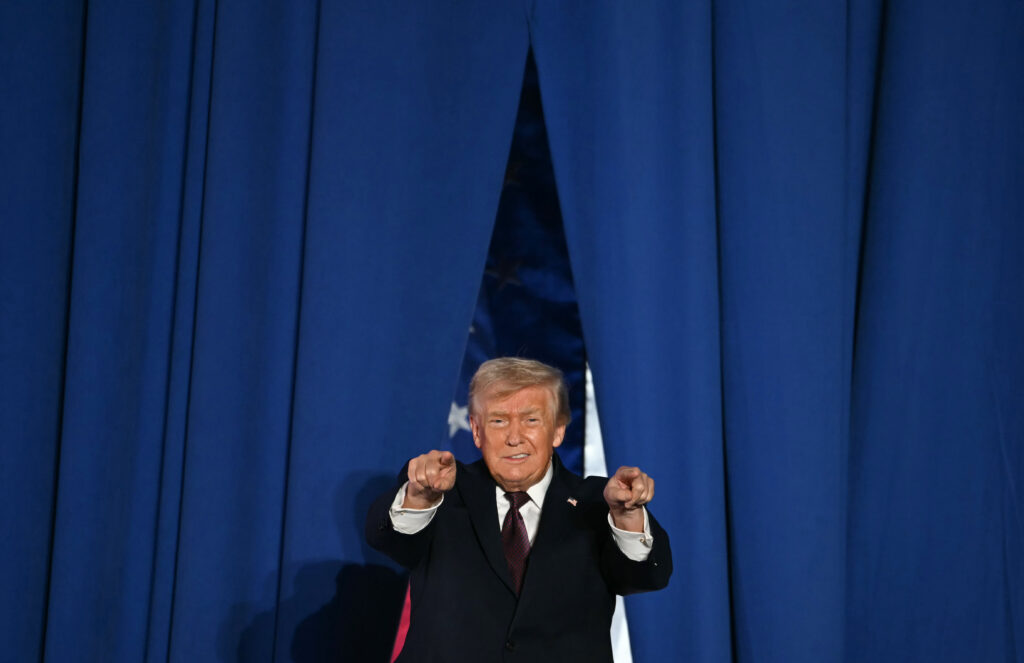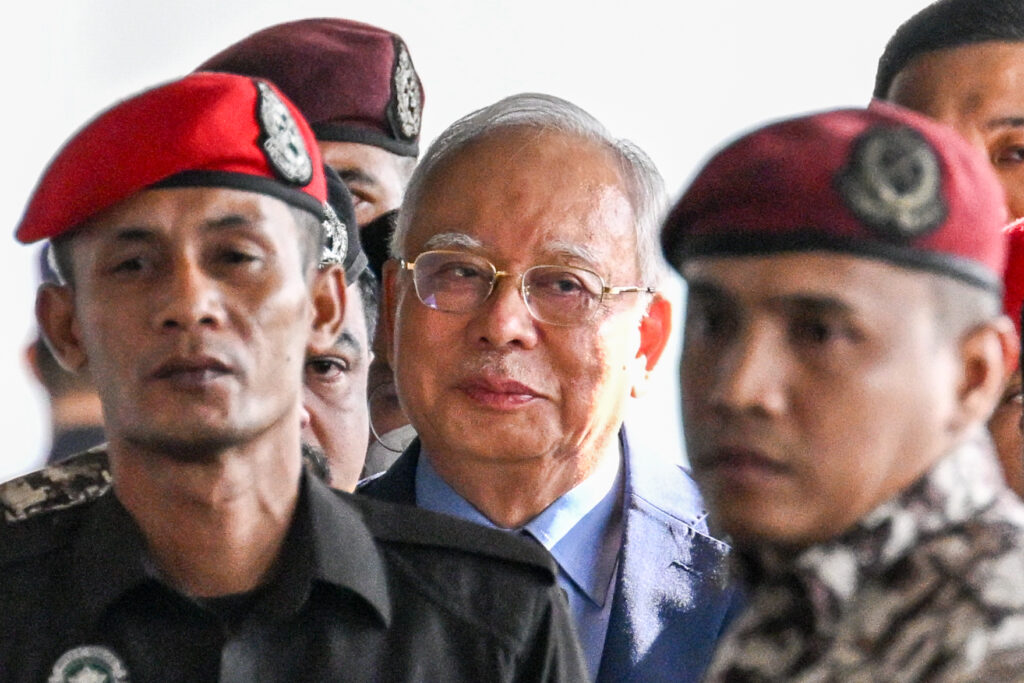Donald Trump, personnalité la plus médiatisée en France en 2025, une première (étude)
Le président américain Donald Trump est la personnalité dont les médias ont le plus parlé en France en 2025, alors que cette première place revient d’ordinaire au chef de l’État français, selon un baromètre annuel dévoilé vendredi par Ouest-France.”Pour la première fois depuis le lancement de cette étude en 2013, ce n’est pas le président français en exercice qui est la personnalité la plus citée dans les médias du pays”, souligne Ouest-France dans l’article qui accompagne les résultats de ce baromètre réalisé par Tagaday, plateforme de veille sur les médias.Selon ces résultats, Donald Trump “a vu son nom écrit ou prononcé dans près d’un million de contenus en 2025 (précisément 947.294) contre 671.125 pour” Emmanuel Macron, deuxième.Le top 5 est complété par l’ex-Premier ministre François Bayrou, le président russe Vladimir Poutine et l’ex-ministre de l’Intérieur Bruno Retailleau.Marine Le Pen, présidente du groupe RN à l’Assemblée nationale, est la seule femme du top 10 (8e). Le top 20 n’en compte que deux (l’autre est la chanteuse Santa, 19e) et le top 50 que neuf. Le capitaine de l’équipe de France de foot, Kylian Mbappé, est le premier sportif (13e).La politique domine ce classement: le top 50 compte trente figures politiques nationales ou étrangères, contre douze issues de la culture et des médias, six du sport et deux du monde économique et des affaires.Ce classement des 1.000 personnalités les plus médiatisées dans la presse française a été réalisé du 1er janvier au 15 décembre.Il est fondé sur l’analyse informatique de plus de 5.500 programmes d’information (diffusés par 410 chaînes et stations TV/radio pour une moyenne de 2.400 heures quotidiennes) et d’une sélection de 3.000 publications de presse écrite (papier et en ligne).
Asia markets edge up as precious metals surge
Asian stocks edged higher on Friday amid holiday-thinned trade and with some exchanges closed for Boxing Day, while precious metals extended their year-long rally towards record highs.Silver reached $75 an ounce for the first time and gold continued to hover around its own record price, with geopolitical risk elevated as US military and economic pressure on Venezuela persists.Regional markets extended their upward rise after Wall Street saw US shares close at a high this week. Most markets across the world were shuttered Thursday for Christmas. Tokyo, Shanghai, Seoul and Taipei all rose by closing time on Friday. Markets in Hong Kong, Australia and most of Europe were closed. Analysts have projected a “Santa Claus rally” — the phenomenon where prices tend to rise during the last five days of December and the first two days of the new year. The movement came after traders in New York pushed the S&P 500 to an all-time high before the Christmas break in response to figures showing the world’s top economy expanded 4.3 percent in the third quarter.On Friday, silver pushed to a record $75 an ounce and gold remained above $4,500 an ounce, with US-Venezuela tensions adding to expectations that the Federal Reserve will keep cutting rates next year.Geopolitical worries have grown as Washington pressures Caracas with a blockade of sanctioned oil vessels sailing to and from Venezuela.The yen remained relatively steady Friday but saw a general rebound this week, after Japanese officials said they were prepared to step in to support the currency. Japan’s government on Friday approved a record 122 trillion yen ($782 billion) budget, in part boosting defence spending, as inflation in the country persists. – Key figures at around 0700 GMT – Tokyo – Nikkei 225: UP 0.7 percent at 50,750.39 (close) Shanghai – Composite: UP 0.1 percent at 3,963.68 (close) Dollar/yen: UP at 156.31 yen from 155.98 yen on ThursdayEuro/dollar: DOWN at $1.1775 from $1.1782Pound/dollar: DOWN at $1.3485 from $1.3529Euro/pound: UP at 87.31 pence from 87.21 penceWest Texas Intermediate: UP 0.3 percent at $58.53 per barrelBrent North Sea Crude: UP 0.2 percent at $62.39 per barrelNew York – Dow: UP 0.6 percent at 48,731.16 (close)London – FTSE 100: DOWN 0.2 percent at 9,870.68 (close)
Scandale de corruption en Malaisie: l’ex-Premier ministre Najib Razak attend son verdict
Déjà emprisonné, l’ex-Premier ministre malaisien Najib Razak doit connaître vendredi le verdict d’un nouveau procès lié au tentaculaire scandale de corruption 1MDB en Malaisie, qui risque de le maintenir pour des années derrière les barreaux.Fils de l’un des pères fondateurs de la Malaisie, l’ancien dirigeant de 72 ans est jugé pour quatre chefs d’accusation d’abus de pouvoir en lien avec des pots-de-vin présumés d’environ 2,28 milliards de ringgits (554 millions de dollars) provenant du fonds souverain malaisien 1Malaysia Development Berhad (1MDB), ainsi que pour 21 chefs d’accusation de blanchiment d’argent.Le détournement de centaines de millions de dollars de ce fonds censé oeuvrer au développement économique de la Malaisie, pour des dépenses privées comme l’achat d’un yacht géant ou des toiles de Monet ou Van Gogh, avait déclenché des enquêtes aux Etats-Unis, en Suisse et à Singapour. L’audience de vendredi s’est ouverte vers 9H00 (01H00 GMT) devant la Haute Cour de Kuala Lumpur, réunie à Putrajaya, la capitale administrative de la Malaisie.Le président de la cour, Collin Lawrence Sequerah, a commencé à lire un long verdict, avant de faire une pause pour la prière du vendredi trois heures plus tard. L’audience doit reprendre à 15H00 (07H00 GMT).Najib Razak, au pouvoir de 2009 à 2018, purge déjà une peine de six ans de prison après avoir été condamné dans une autre affaire liée à ce scandale. Dans son nouveau procès, chaque chef d’accusation d’abus de pouvoir est passible d’une peine pouvant aller jusqu’à 20 ans de prison et d’une amende pouvant atteindre cinq fois le montant du pot-de-vin.S’il est acquitté, il retournera à la prison de Kajang, près de Kuala Lumpur, pour purger le reste de sa peine initiale.- “Contrôle absolu” -L’ex-dirigeant malaisien a présenté des excuses pour le scandale 1MDB qui s’est déroulé pendant son mandat, mais maintient qu’il ignorait tout des transferts illégaux provenant du fonds aujourd’hui dissous.Selon le parquet, Najib Razak a pourtant profité de ses positions de Premier ministre, ministre des Finances et président du conseil consultatif du fonds pour transférer d’importantes sommes de la société vers son compte personnel il y a plus de dix ans. L’accusation a présenté des relevés bancaires, les déclarations de plus de 50 témoins et d’autres documents à charge, tout en réfutant les arguments de la défense qui imputaient à l’homme d’affaires Jho Low (de son vrai nom Low Taek Jho), l’essentiel de la responsabilité de l’affaire. Longtemps très proche de Najib Razak, il est considéré comme le cerveau du pillage du fonds d’investissement, mais il est actuellement en fuite.Najib Razak “se présente comme la victime de subordonnés rebelles, alors qu’en réalité il était l’unique décideur et le plus puissant”, a estimé le procureur adjoint Ahmad Akram Gharib. Le juge Sequerah a écarté les arguments de la défense selon lesquels de l’argent versé sur le compte de l’ex-Premier ministre provenait de dons du Moyen-Orient.”Les preuves indiquent clairement qu’il ne s’agissait pas d’une coïncidence, mais témoignent d’une relation dans laquelle Jho Low agissait comme un prête-nom ou un agent de l’accusé en ce qui concerne la gestion des affaires de 1MDB” a-t-il souligné.Les avocats de M. Razak ont assuré que leur client ignorait que la direction de 1MDB travaillait main dans la main avec Jho Low pour détourner d’importantes sommes d’argent du fonds.L’avocat Muhammad Shafee Abdullah a affirmé à la presse la semaine dernière que Najib Razak n’avait “jamais bénéficié d’un procès équitable” et a réitéré ses accusations contre Jho Low.L’ancien dirigeant a néanmoins subi un revers lundi, se voyant refuser sa demande de commutation de sa peine existante en assignation à résidence.Une nouvelle condamnation porterait un coup supplémentaire à son influence persistante au sein du plus ancien parti politique de Malaisie, l’Organisation nationale unifiée des Malais (Umno).Le scandale a joué un rôle majeur dans la défaite aux élections de 2018 de Najib Razak et de l’Umno, qui était au pouvoir depuis l’indépendance de cette ex-colonie britannique en 1957.



